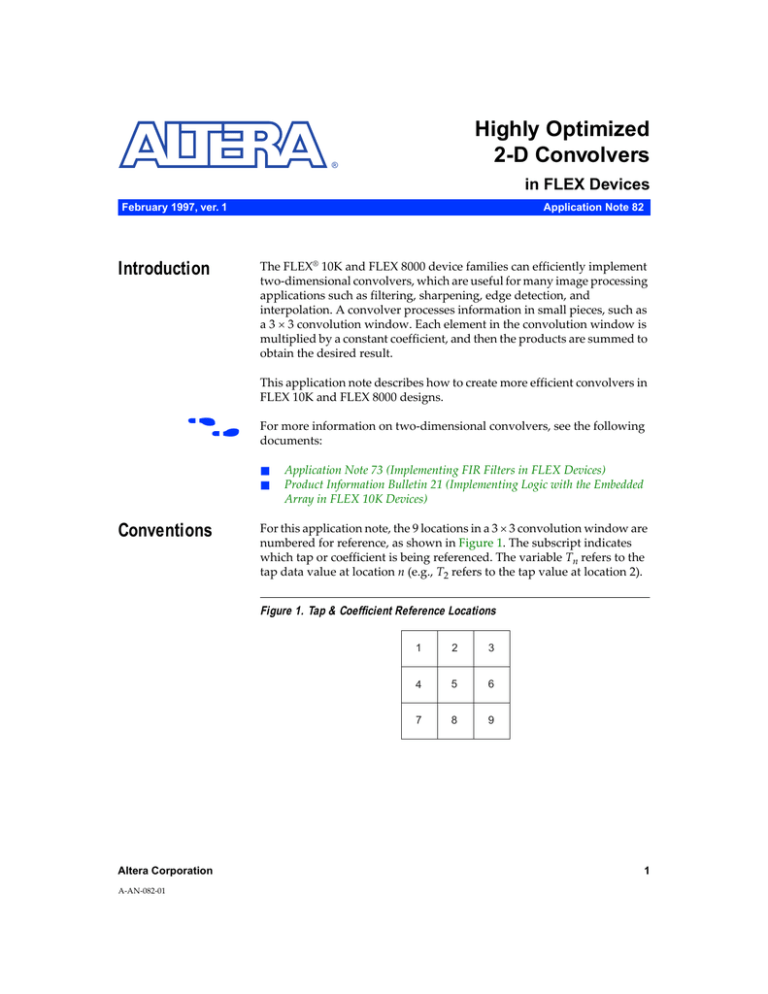
Highly Optimized
2-D Convolvers
®
in FLEX Devices
February 1997, ver. 1
Introduction
Application Note 82
The FLEX® 10K and FLEX 8000 device families can efficiently implement
two-dimensional convolvers, which are useful for many image processing
applications such as filtering, sharpening, edge detection, and
interpolation. A convolver processes information in small pieces, such as
a 3 × 3 convolution window. Each element in the convolution window is
multiplied by a constant coefficient, and then the products are summed to
obtain the desired result.
This application note describes how to create more efficient convolvers in
FLEX 10K and FLEX 8000 designs.
f
For more information on two-dimensional convolvers, see the following
documents:
■
■
Conventions
Application Note 73 (Implementing FIR Filters in FLEX Devices)
Product Information Bulletin 21 (Implementing Logic with the Embedded
Array in FLEX 10K Devices)
For this application note, the 9 locations in a 3 × 3 convolution window are
numbered for reference, as shown in Figure 1. The subscript indicates
which tap or coefficient is being referenced. The variable Tn refers to the
tap data value at location n (e.g., T2 refers to the tap value at location 2).
Figure 1. Tap & Coefficient Reference Locations
Altera Corporation
A-AN-082-01
1
2
3
4
5
6
7
8
9
1
AN 82: Highly Optimized 2-D Convolvers in FLEX Devices
Conventional
Convolver
Figure 2 shows the coefficient window for a sample convolver design.
Figure 2. Coefficient Window
Row 1
1.5
0.375
–0.625
Row 2
0.375
0.125
–0.125
Row 3
1.25
–0.125
0.250
Figure 3 shows a block diagram of a conventional convolver using the
coefficients shown in Figure 2. In this convolver, the coefficients remain
constant and the tap values change every clock cycle as new data is shifted
into the convolver.
2
Altera Corporation
AN 82: Highly Optimized 2-D Convolvers in FLEX Devices
Figure 3. Conventional Convolver Block Diagram
Row 1
8
Row 2
8
Row 3
8
8
1.25
–0.125
16
16
T8
T9
0.25
8
8
8
8
T7
T4
0.375
16
0.125
16
16
8
8
T5
–0.125
T6
1.5
16
16
17
17
17
18
8
T1
8
T2
0.375
16
–0.625
T3
16
17
18
19
20
Y
The output of each register is called a tap (Tn). Each tap is multiplied by
the corresponding coefficient (Cn) from Figure 2, and then the products
are summed to produce the final result (Y). The equation for the convolver
in Figure 3 is shown below:
9
Y =
∑ T n Cn
1
Altera Corporation
3
AN 82: Highly Optimized 2-D Convolvers in FLEX Devices
Building the conventional two-dimensional convolver for maximum
speed requires 9 multipliers and an adder tree consisting of 8 separate
adders. Assuming the data and coefficients are 8 bits wide and the
coefficients are constant, each multiplier would require 36 logic elements
(LEs) and each adder would require one LE per bit, for a total of 539 LEs
for the entire design.
Highly
Optimized
Convolver
You can improve the speed and logic efficiency of the conventional
convolver by taking advantage of the numeric relationships between the
coefficients. Although the convolution window in Figure 2 is asymmetric,
all of the coefficients are integer multiples of 0.125. By rewriting the
coefficient window and substituting K = 0.125, you obtain the window
shown in Figure 4.
Figure 4. Modified Coefficient Window
12
3
–5
3
1
–1
10
–1
2
×
K
In this example, you can take advantage of the fact that all the factored
coefficients are integers. Multiplying the taps by the coefficients 12, 3, 5, 1,
and 10 is simple because all the integers are the sum of powers of 2. For
example, multiplying tap T1 by 12 is the same as adding 8T1 and 4T1 (i.e.,
12T1 = 8T1 + 4T1). Because 8 and 4 are both powers of 2, multiplication can
be avoided. Instead, T1 can be shifted left by 3 bits and 2 bits, respectively.
Therefore, 12T1 can be computed with a single adder that is only 10 bits
wide, assuming T1 is an 8-bit number. For example, if T1 = 11111111B, you
can calculate 12T1 as shown in Figure 5.
Figure 5. Multiplying 12 × T1
11111111000
+ 1111111100
101111110100
=
8 × T1
+ 4 × T1
12 × T1
Because the 2 least significant bits (LSBs) of 8T1 and 4T1 are always 0, the
2 extra bits in the adder are not required. Therefore, this calculation
requires only 10 LEs.
4
Altera Corporation
AN 82: Highly Optimized 2-D Convolvers in FLEX Devices
Similarly, 3, 5, and 10 can each be computed with a single adder.
Multiplying or dividing by any power of 2 is a shift left or right and does
not require any LEs. However, LEs are required to add the product into
the final result.
To further improve the logic efficiency of this design, you can take
advantage of the “sparseness” of the coeffiecients (i.e., the relatively few
1s in the coefficients). The basic method is to add or subtract various
multiples of 2 of the taps to obtain the desired multiplication factor—e.g.,
add together all taps that have a 1 in the most significant bit (MSB). Table 1
lists each tap’s coefficient and its binary representation. Numbers in
parentheses are negative.
Table 1. Binary Representation of the 9 Coefficients
Coefficient
C1
C2
C3
C4
C5
C6
C7
C8
C9
Weight
Decimal
Binary
12
1100
3
0011
–5
(0101)
3
0011
1
0001
–1
(0001)
10
1010
–1
(0001)
2
0010
To perform these calculations efficiently in parallel, begin by adding taps
with a 1 in the MSB and work your way down to the LSB. In this example,
the MSB of C1 and C7 is 1. Therefore, you should calculate an intermediate
result by adding C1 and C7, remembering to shift the product left by 3 bits
before adding it to the final result.
Similarly, the (MSB – 1) bit of C1 and C3 is 1. In this case, compute
(C1 – C3), remembering to shift the product left by 2 bits before adding it
to the final result.
Repeat this procedure for the next 2 bits of the weight, i.e., the (MSB – 2)
bit and the LSB. Next, add all of the products to produce the final result.
Last, multiply the final result by K. Because 0.125 is a power of 2, no
multiplication is necessary—the final result is simply shifted right by 3
bits.
Altera Corporation
5
AN 82: Highly Optimized 2-D Convolvers in FLEX Devices
The following steps show mathematically how to use this method to
create a highly optimized convolver design, or any other multiply and
accumulate (MAC) design. All numbers are in binary.
Y = T1C1 + T2C2 + T3C3 + T4C4 + T5C5 + T6C6 + T7C7 + T8C8 + T9C9
1. Substitute the binary values of the coefficients:
Y = (T1 × 1100) + (T2 × 0011) – (T3 × 0101) + (T4 × 0011) +
(T5 × 0001) – (T6 × 0001) + (T7 × 1010) – (T8 × 0001) + (T9 × 0010)
2. Factor out 8 (1000B):
Y = [(T1 + T7) × 1000] + (T1 × 100) + (T2 × 011) – (T3 × 101) +
(T4 × 011) + (T5 × 001) – (T6 × 001) + (T7 × 010) – (T8 × 001) + (T9 × 010)
3. Factor out 4 (100B):
Y = [(T1 + T7) × 1000] + [(T1 – T3) × 100] + (T1 × 00) + (T2 × 11) –
(T3 × 01) + (T4 × 11) + (T5 × 01) – (T6 × 01) + (T7 × 10) – (T8 × 01) +
(T9 × 10)
4. Factor out 2 (10B):
Y = [(T1 + T7) × 1000] + [(T1 – T3) × 100] + [(T2 + T4 + T7 + T9) × 10] +
(T1 × 0) + (T2 × 1) – (T3 × 1) + (T4 × 1) + (T5 × 1) – (T6 × 1) + (T7 × 0) –
(T8 × 1) + (T9 × 0)
5. Add the remaining non-zero terms:
Y = [(T1 + T7) × 1000] + [(T1 – T3) × 100] + [(T2 + T4 + T7 + T9) × 10] +
[(T2 – T3 + T4 + T5 – T6 – T8)] × 1
6. Group the terms by significance and perform more factoring:
Y = [(T1 + T7) × 10] + [(T1 – T3) × 1] × 10 + [(T2 + T4 + T7 + T9) × 1 × 10] +
[(T2 – T3 + T4 + T5 – T6 – T8) × 1]
6
Altera Corporation
AN 82: Highly Optimized 2-D Convolvers in FLEX Devices
Figure 6 shows a block diagram of the multiply and accumulate section of
the optimized convolver.
Figure 6. Highly Optimized Convolver Block Diagram
Shift Left
by 3 Bits
Tap Position 1
Shift Left by 1 Bit
Shift Left
by 2 Bits
7 1
3
2
No Shift
4 7
9
4 5
2
6
3
8
8
8
8
8
8
8
8
8
8
8
8
8
8
8
+
+
+
–
+
+
+
+
+
+
+
–
+
+
9
9
Shift Left
by 1 Bit
+
9
9
+
+
11
Shift Left
by 1 Bit
+
9
9
9
+
+
12
+
+
+
11
13
Shift Left
by 1 Bit
–
+
+
15
Y
The highly optimized fixed-coefficient convolver uses 215 LEs, as
opposed to the 529 LEs required by the conventional convolver shown in
Figure 3—a savings of 60%.
The highly optimized design, written in the Altera Hardware Description
Language (AHDL™), is shown in Figure 7. This pipelined design will run
at over 90 MHz in a FLEX 8000A device with a -2 speed grade, a speed that
is the equivalent of 810 MIPS for only 214 LEs.
1
Altera Corporation
This design—named fstconv—can be downloaded from the
Altera world-wide web site at http://www.altera.com.
7
AN 82: Highly Optimized 2-D Convolvers in FLEX Devices
Figure 7. fstconv.tdf File (Part 1 of 2)
SUBDESIGN fstconv
(
in[3..1][8..1]
out[15..1]
clk
)
VARIABLE
row1[3..1][8..1]
row2[3..1][8..1]
row3[3..1][8..1]
: INPUT;
: OUTPUT;
: INPUT;
: DFF; -- Row 1 of shift register
: DFF; -- Row 2 of shift register
: DFF; -- Row 3 of shift register
inter_sh3[9..1]
:
inter_sh2[9..1]
:
inter_sh1_t[2..1][9..1] :
inter_sh1[10..1]
:
inter_sh0_t1[3..1][9..1] :
inter_sh0_t2a[10..1]
:
inter_sh0_t2b[9..1]
:
inter_sh0[11..1]
:
inter_3_2[11..1]
:
inter_3_2_1[13..1]
:
inter_3_2_1_0[15..1]
:
BEGIN
DFF;
DFF;
DFF;
DFF;
DFF;
DFF;
DFF;
DFF;
DFF;
DFF;
DFF;
------
Intermediate shift by 3 node
Intermediate shift by 2 node
Shift by 1 node
More shift by 1 node
Shift by 0
-- Shift by 3 + shift by 2
-- inter_3_2 + shift by 1
-- inter_3_2_1 + shift by 0
-- Connect the clock to all the internal registers
(inter_sh3[].clk, inter_sh2[].clk, inter_sh1_t[][].clk,
inter_sh1[].clk, inter_sh0_t1[][].clk,
inter_sh0_t2a[].clk, inter_sh0_t2b[].clk,
inter_sh0[11..1].clk, inter_3_2[].clk, inter_3_2_1[].clk
inter_3_2_1_0[].clk) = clk;
-- Connect the shift register:
-- Data will shift from left to right, which will be 1 to 3
row1[1][] = in[1][];
row2[1][] = in[2][];
row3[1][] = in[3][];
row1[3..2][] = row1[2..1][];
row2[3..2][] = row2[2..1][];
row3[3..2][] = row3[2..1][];
row1[][].clk = clk;
row2[][].clk = clk;
row3[][].clk = clk;
8
Altera Corporation
AN 82: Highly Optimized 2-D Convolvers in FLEX Devices
Figure 7. fstconv.tdf (Part 2 of 2)
-- The shift by 3 data
inter_sh3[]
= (row1[1][8], row1[1][]) + (row3[1][8], row3[1][]);
-- The shift by 2 data
inter_sh2[]
= (row1[1][8], row1[1][]) - (row1[3][8], row1[3][]);
-- The shift by 1 data
inter_sh1_t[1][] = (row1[2][8], row1[2][]) +
(row2[1][8], row2[1][]); -- 2 + 4
inter_sh1_t[2][] = (row3[1][8], row3[1][]) +
(row3[3][8], row3[3][]); -- 7 + 9
inter_sh1[]
= (inter_sh1_t[1][9], inter_sh1_t[1][]) +
(inter_sh1_t[2][9], inter_sh1_t[2][]);
-- The shift by zero data
inter_sh0_t1[1][] = (row1[2][8], row1[2][]) +
(row2[1][8], row2[1][]);
inter_sh0_t1[2][] = (row2[2][8], row2[2][]) (row2[3][8], row2[3][]);
inter_sh0_t1[3][] = (row1[3][8], row1[3][]) +
(row3[2][8], row3[2][]);
inter_sh0_t2a[] = (inter_sh0_t1[1][9], inter_sh0_t1[1][]) +
(inter_sh0_t1[2][9], inter_sh0_t1[2][]);
inter_sh0_t2b[] = inter_sh0_t1[3][];
inter_sh0[]
= (inter_sh0_t2a[10], inter_sh0_t2a[]) (inter_sh0_t2b[9], inter_sh0_t2b[9],
inter_sh0_t2b[]);
-- Shift by 3 + shift by 2
inter_3_2[]
= (inter_sh3[9], inter_sh3[], gnd) +
(inter_sh2[9], inter_sh2[9], inter_sh2[]);
-- Shift by 3 + shift by 2 + shift by 1
inter_3_2_1[]
= (inter_3_2[11], inter_3_2[], gnd) +
(inter_sh1[10], inter_sh1[10], inter_sh1[10],
inter_sh1[]);
-- Shift by 3 + 2 + 1 + 0
inter_3_2_1_0[] = (inter_3_2_1[13], inter_3_2_1[], gnd) +
(inter_sh0[11], inter_sh0[11],
inter_sh0[11], inter_sh0[11], inter_sh0[]);
-- Output
out[] =
END;
Altera Corporation
inter_3_2_1_0[];
9
AN 82: Highly Optimized 2-D Convolvers in FLEX Devices
Conclusion
10
This application note shows how to improve the logic efficiency of a
convolver design when the coefficients can be factored and are sparse. To
reduce the amount of logic required for your convolver design, use the
following tips:
■
If possible, factor out a common coefficient, so that a single final
multiplication can be performed at the end (if the factor is a multiple
of 2, multiplication is not required).
■
If possible, set all the coefficients to a power of 2 or to the sum of a few
powers of 2. Logic is not required to multiply a tap by the coefficients
1, 2, 4, and 8—the taps are just shifted left by 0, 1, 2, or 3 bits,
respectively. Likewise, the numbers 3, 5, 6, 9, 10, and 12 can be
calculated with a single adder. The other numbers below 16 will
require more logic, but will still be more efficient than using the
conventional method.
Altera Corporation
AN 82: Highly Optimized 2-D Convolvers in FLEX Devices
®
2610 Orchard Parkway
San Jose, CA 95134-2020
(408) 894-7000
http://www.altera.com
Applications Hotline:
(800) 800-EPLD
Customer Marketing:
(408) 894-7104
Literature Services:
(888) 3-ALTERA
lit_req@altera.com
11
Altera, FLEX, FLEX 10K, AHDL, and FLEX 8000 are trademarks and/or service marks of Altera Corporation
in the United States and other countries. Altera acknowledges the trademarks of other organizations for their
respective products or services mentioned in this document. Altera products are protected under numerous
U.S. and foreign patents and pending applications, maskwork rights, and copyrights. Altera warrants
performance of its semiconductor products to current specifications in accordance with Altera’s standard
warranty, but reserves the right to make changes to any products and services at any time without notice.
Altera assumes no responsibility or liability arising out of the application or use of any
information, product, or service described herein except as expressly agreed to in writing
by Altera Corporation. Altera customers are advised to obtain the latest version of device
specifications before relying on any published information and before placing orders for
products or services.
Copyright 1997 Altera Corporation. All rights reserved.
Altera Corporation
Printed on Recycled Paper.


